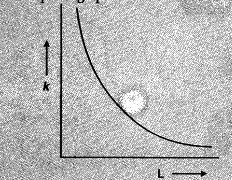State the underlying principle of a potentiometer. Why is it necessary to (i) use a long wire, (ii) have uniform area of cross-section of the wire and (iii) use a driving cell whose emf is taken to be greater than the emf of the primary cells ?
(b) In a potentiometer experiment, if the area of the cross-section of the wire increases uniformly from one end to the other, draw a graph showing how potential gradient would vary as the length of the wire increases from one end.
(a) Principle of potentiometer :
The potential drop across the length of a steady current carrying wire of uniform cross-section is proportional to the length of the wire.
(i) We use a long wire to have a lower value of
potential gradient (i.e. a lower ‘least count’ or greater sensitivity of the potentiometer.
(ii) The area of cross-section has to be uniform to
get a ‘uniform wire’ as per the principle of the potentiometer.
(iii) The emf of the driving cell has to be greater than
the emf of the primary cells as otherwise no balance point would be obtained.
(b) Potential gradient k = V/L
The required graph is as shown below
